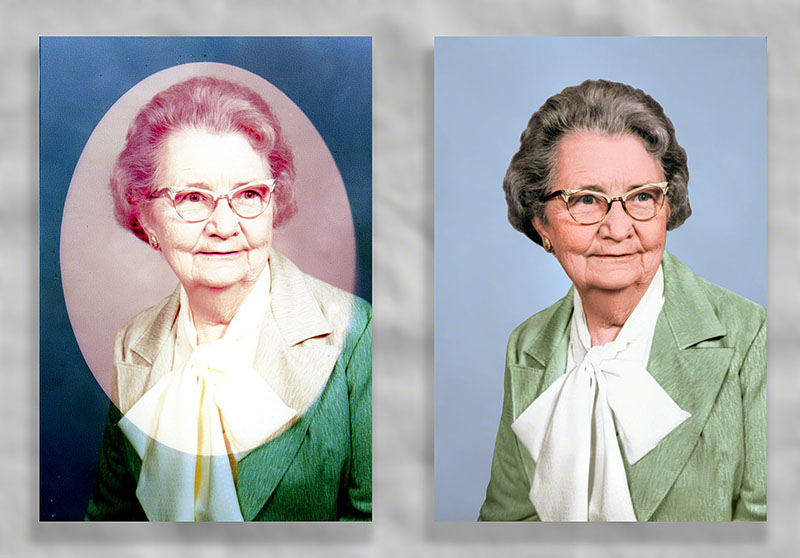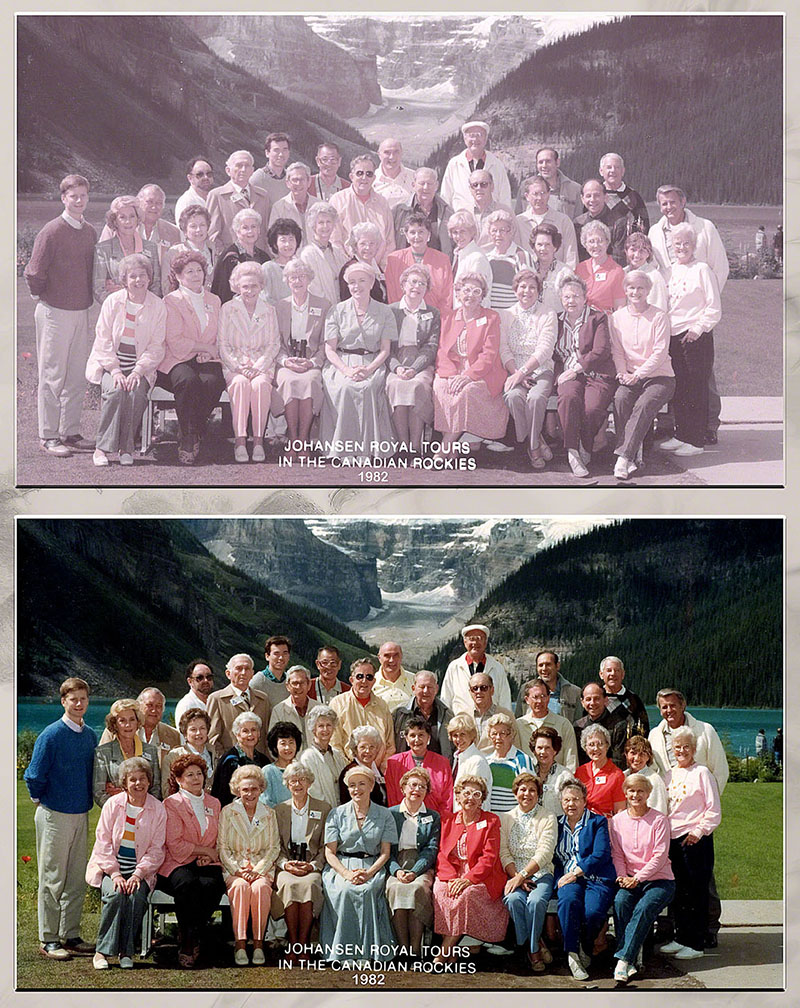Why Do Photographs Fade and Change Colors?
Photographs represent irreplaceable memories. They capture a particular moment in time that holds sentimental value. Family photographs taken a century ago create an emotional moment that should be treasured. These old photographs are historical records as well as irreplaceable memoirs of priceless moments in time. Once captured, these photographs often create an impression that they are immortal. Understanding how to maintain or restore them can help you to preserve these memories for future generations.
Photo Degradation and Discoloration
Degradation of these photographic images is a common problem. At first glance, the damage might be so severe that it seems like there is nothing that can be done. Many old photographs appear with water damage, cracks, spotting, faded colors, and other issues. Fortunately, restoration services are available using the tools of modern technology to meticulously repair some of the most common forms of damage. For example, sepia toning restoration services can transform an image that is faded and discolored and convert into an incredibly clean image complete with the smallest details intact.
Repairing damage to old photographs may seem like magic to some, but it's really just a form of art. Restoration can improve images that develop purple shadows, faded sepia tone, or red and orange "color casts." Honestly, whether it's color, fading, or a photo torn in 10 pieces, it can be fixed. It's still possible to resurrect that old picture and print it like the day it was first taken. Regardless of the issue at hand, the best restoration services in Houston can address it.
Why Do Photographs Fade?
Most photographs will be exposed to the ultraviolet rays from the sun at some point in time. Even small amounts of exposure can begin the process of degeneration. Powerful UV rays have a substantial effect on the chemistry used to produce the photographs, and those same rays can drastically alter bonds and emulsions used to create the image. Eventually, dye, pigment, and ink will break down. As they break down, portions of the photo's "face" separate into tiny pieces. This results in a faded, hazed, or discolored state.
Why Do Color Photographs "Change Color?"
Over the years, color photographs undergo changes that can be startling. The most common term for this process is photo-degradation. This usually refers to the changes in the photo that happen after exposure to sunlight or UV rays. The image is made up of molecules within the dyes and pigments used to construct the color photograph. The rays from the sun contain energized photons capable of breaking down these molecules. This results in a destructive effect that appears to the human eye as fading. In basic terms, light won't reflect the same way after exposure to the sun's powerful UV rays, so the appearance of the photograph changes in reaction to it.
More Causes of Photo Damage
There are other reasons that color photographs can change. For example, exposure to moisture can affect the hues of a color photograph rapidly. This happens through a process known as oxidation, but the type of ink used will also play a role in maintaining the integrity of an old picture. For example, dye-based inks tend to degrade faster than pigment-based inks, which contain particles within a clear resin that reduces the effects of oxidation.
Color restoration and photo restoration services are often used to fix old photos that have been damaged through exposure to sun, moisture, or humidity. Spots may appear once a photograph is exposed to moisture. Also, mold can grow in any place where there is enough moisture. Some people store their negatives, slides, documents, and photographs in a basement or attic area where leaks and exposure to high degrees of humidity are likely. Even more people (like Sandy and I) live on the Texas Gulf Coast. With the exception of places like Vietnam and the Philippines, you can't get a more perfect blend of heat and humidity if you genuinely want to destroy your photos quickly!
Regardless of the cause of the damage, it is possible to restore priceless details to these images. The key is to prevent damage whenever possible. The next option is restoration, but it is vital to do everything possible to prevent damage from happening in the first place.
How to Prevent Photo Fading
There are specific actions that you can take to slow down the damage. Frames that are designed to repel harmful UV rays are very popular with people who take an active interest in preserving their photographs for as long as possible. Make sure that household chemicals are never used near your images.
This includes the chemicals that are contained in adhesive surfaces like tape, which shouldn't be used to hang the pictures on the walls or to the surface of a picture frame. This small point of contact can still initiate the chemical reaction that causes fading and other forms of photo-degradation.
Don't frame your heirloom photo with a piece of cardboard or magazine paper behind it. Photo paper (especially the back) is quite porous. Cardboard contains some surprisingly nasty chemicals, and eventually, those little nasties absorb into the picture itself. Instead, go to any art supply store or visit Amazon. Get some cheap acid-free paper. Use the paper as a "buffer" between the back of your photo and whatever stiff material you use as a matting.
Often, harm may not be detected right away. Many people only discover a damaged photograph after it's been sitting in a dark and moist area of the home for some time. The discovery of the photo often causes a certain amount of euphoria, and this can prevent the person from immediately noticing the damage. Moreover, if you look at the same picture every day, it may be years before you see damage that's actually been there for a long time.
After time passes, some of these problems can become even more exaggerated. For example, sudden exposure to oxygen can rapidly accelerate the degradation process after the photograph has been stored in a sealed container for many years. The shock of the degradation can be alarming, but it is less stressful once you know that restoration is still possible.

Color Restoration and Photo Restoration Services
Heritage Photo Restoration is inarguably the best photo restoration in Houston, but we serve folks all over the country. Color repair and photo restoration are very popular with clients looking to fix or retouch old photos. These valuable services can work wonders on your prized possessions. Some clients just want a slight retouching of a prized photograph, and others might prefer to restore old photos to a more pristine and vibrant condition. Whatever it is that you want, we are happy to do it.
Even if you aren't ready to restore your photos and negatives just yet, please know that the clock is ticking. At least make an effort to have your pictures digitized. This is the only real way to ensure you have a permanent copy of the photo in it's current state. Heritage Photo Restoration can take care of all that for you, and we will provide your digital images on a flash drive, DVD, or web album. It's all your choice. Want TIFF files instead of uncompressed JPG files? No problem.
Protect your photos first. Preserve them properly, and copy them into a format that does NOT degrade further. Once you do that, the precious memory will never truly vanish.
Whether it's one 16x20" picture or 10,000 slides, we can digitize them at an almost absurdly high resolution with optional color correction at a very reasonable cost.
Even if you bring those photos and slides to us in your grandfather's old fishing-tackle box and they smell like bait, we can handle it. When we're done, your scanned images will be carefully repackaged in the most protective way possible.
If you decide later that some of those images do need to be revived, then worry not! You have the digital copy and Heritage ALWAYS keeps a copy of scanned images on backup storage just in case a customer ever comes back.
Once you are ready to restore, we can take care of the contrast, light balance, color integrity, rips, tears, scratches, holes, missing pieces, stains, and even photos stuck to glass.
We're Restoring Yesteryear!
Come down to our little boutique operation and find out why we are the best photo restoration in Houston, Texas. Give us some time with your photos and let us take your breath away. Get answers to any questions you may have about our process. Find out why our scanning services are superior to others (seriously - they really are). Learn why it is so important to print photos on high-quality archival paper or museum-grade paper. We have 26 types of photo paper to choose from. We can also print your restored pictures on solid maple wood, metal, glass, acrylic, canvas, or even postcards.
Want a slideshow video? We specialize in creating memorial tribute slideshows and wedding slideshows set to the music or narrative of your choice.
Need photo books, albums, or true legacy heirloom books? We can do that too. Don't go with some cheap internet services. We can create anything from the most basic photo book to the most exquisite leather-bound and gilded book with unsurpassed quality.

Review - Protect, Preserve, and Restore if Needed
So, in short, here's how to handle that aging, fading, and color loss. Protect your photos from the very beginning. Keep them stored away from high heat and away from bright light. Keep them dry. In humid areas, purchase silica gel packets and keep them with your photos in an airtight box or bag. Those little packets do wonders keeping your photos free from humidity damage. Don't want to purchase the packets? If you are a female, use the ones that come with literally every pair of shoes you buy. If you are a male, simply raid your wife's or mother's shoe closet and take the packets as your own. We are not responsible for any physical or emotional harm you might incur as a result of robbing your relatives like this, so maybe you should just ask first. ?
Archive your photos through digitization. Digital images don't degrade unless they are manipulated as they are uploaded to services like Facebook (they shrink your photos).
If the photos are already damaged and you want them back to their original glory, come visit Jack and Sandy at Heritage Photo Restoration. We're just inside loop 610 - less than a block east on Bellaire Boulevard. Just make a quick right on Bellaire Court and look for the little bungalow with the giant magnolia out at the street.
It's where we bring memories back to life. It is our home. You and your photos are always welcome in our home. Visit us, and we will treat you and yours like family.
